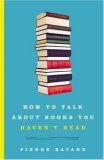How to read
Written on November 23, 2007
My practice is to read nonfiction books straight through, beginning to end – I like to immerse myself in the author’s flow of thought and argument. That is not the method recommended by Paul Edwards (from the University of Michigan School of Information) in the following article:
“How to Read: Strategies for Getting the Most out of Non-Fiction Reading” (links to a 7-page pdf)
He says: “So unless you’re stuck in prison with nothing else to do, NEVER read a non-fiction book from beginning to end.” Though I can’t agree with that, there are some good tips on reading strategies.
Theoretically related is this recent book about reading (or not reading):
How to Talk About Books You Haven’t Read by Pierre Bayard, which has been getting a lot of attention…
 Complete Review has a great page full of links related to this title.
Complete Review has a great page full of links related to this title.



Yeah, reading a non-fiction book from beginning to end is silly. What did the author know, anyway? Why did s/he think that the sequence s/he developed is the best way to read it? Wait… if we don’t trust the author, why are we reading the book?
I’m right now reading the new biography of Alice Roosevelt Longworth and find it hard to imagine why I wouldn’t start at the beginning and read through to the end. And when I read a poem or a play, I read from beginning to end. When I read a history, I read from beginning to end.
Now, cookbooks—I can understand skipping around in a cookbook. Or an encyclopedia. Or a reference manual.
But a book that is developed as a sustained narrative? Why would one NOT read it in order?